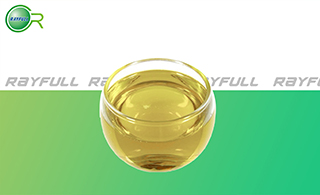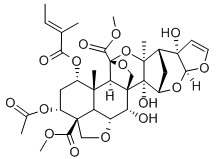Azadirachtin
  印楝素 印楝素
Introduction: The key insecticidal ingredient found in the neem tree is azadirachtin, a naturally occurring substance that belongs to an organic molecule class called tetranortriterpenoids. It is structurally similar to insect hormones called "ecdysones," which control the process of metamorphosis as the insects pass from larva to pupa to adult. Metamorphosis requires the careful synchrony of many hormones and other physiological changes to be successful, and azadirachtin seems to be an "ecdysone blocker." It blocks the insect's production and release of these vital hormones. Insects then will not molt, thus breaking their life cycle. Azadirachtin may also serve as a feeding deterrent for some insects. Depending on the stage of life-cycle, insect death may not occur for several days. However, upon ingestion of minute quantities, insects become quiescent and stop feeding. Residual insecticidal activity is evident for 7 to 10 days or longer, depending on insect and application rate. Azadirachtin is used to control whiteflies, aphids, thrips, fungus gnats, caterpillars, beetles, mushroom flies, mealybugs, leafminers, gypsy moths and others on food, greenhouse crops, ornamentals and turf.
Common name: Azadirachtin
Another name: Azadirachtin A; Bioneem; NeemAzal; Azadirachtin-A; UNII-O4U1SAF85H; etc.
Chemical name: dimethyl (2aR,3S,4S,4aR,5S,7aS,8S,10R,10aS,10bR)-10- acetoxy-3,5-dihydroxy-4-[(1aR,2S,3aS,6aS,7S,7aS)-6a-hydroxy-7a-methyl-3a,6a,7,7a-tetrahydro-2,7-methanofuro[2,3-b]oxireno[e]oxepin-1a(2H)-yl]-4-methyl-8-{[(2E)-2-methylbut-2-enoyl]oxy}octahydro-1H-naphtho[1,8a-c:4,5-b'c']difuran-5,10a(8H)-dicarboxylate
Empirical formula: C35H44O16
Structural formula:

Mol. Weight: 720.71 g/mol
CAS No.: 11141-17-6
Specifications
Leading Azadirachtin supplier
Azadirachtin 0.6% EC
Packing:
BULK PACKING
Powder: 25kg/Bag, 25kg/Drum, 50kg/Drum etc.
Liquid: 200L/Drum, 20L/Drum, 10L/Drum etc.
SMALL PACKING
Powder: 1kg/Alu bag, 500g/Alu bag, 200g/Alu bag, 100g/Alu bag, 50g/Alu bag, 15g/Alu bag etc.
Liquid: 5L/Drum, 1L/Bottle, 500ml/Bottle, 250ml/Bottle, 100ml/Bottle, 50ml/Bottle etc.
Customerized packing label
Azadirachtin FAO standard
Professional registration
HAZARDS IDENTIFICATION
Hazard statement(s)
H317 (100%): May cause an allergic skin reaction.
H400 (50%): Very toxic to aquatic life.
H410 (50%): Very toxic to aquatic life with long lasting effects.
Precautionary statement(s)
P261: Avoid breathing dust/fume/gas/mist/vapors/spray.
P272: Contaminated work clothing should not be allowed out of the workplace.
P273: Avoid release to the environment.
P280: Wear protective gloves/protective clothing/eye protection/face protection.
P302+P352: IF ON SKIN: wash with plenty of water.
P321: Specific treatment (see ... on this label).
P333+P313: IF SKIN irritation or rash occurs: Get medical advice/attention.
P363: Wash contaminated clothing before reuse.
P391: Collect spillage.
P501: Dispose of contents/container to ...
Supplemental Hazard Statements: none.
MAMMALIAN TOXICOLOGY
Acute toxicity: 1) Acute oral LD50 for rats is >5000 mg/kg. 2) Acute dermal LD50 for rats is >2000 mg/kg. 3) Acute inhalation toxicity LC50 (4 h) for rats is>0.72 mg/L. 4) Skin irritation: Non-irritating to skin (rabbits). 5) Eye irritation: Non-irritating to eyes (rabbits). 6) Skin sensitization for guinea pig: Non-sensitizing.
ADI: 0-0.1 mg/kg b.w.
Classification:
WHO Classification: NL (Not listed)
EC Risk Classification: Xn - Harmful: R43
US EPA Classification (formulation): IV (Caution - Not acutely toxic)
ECOTOXICOLOGY
Effect on birds: Acute oral LD50 for Bobwhite quail is >1000 mg/kg. Effect on fish: Acute LC50 (96 h) for Rainbow trout is >2.22 mg/l. Effects on aquatic invertebrates: Acute EC50 (48 h) for Daphnia magna is 3.54 mg/l. Effects on algae: Acute 72 hour EC50 for Pseudokirchneriella subcapitata is >5.76 mg/l. Effects on bees: contact acute 48 hour LD50 is >11.81 μg/bee, oral acute 48 hour LD50 is >8.1 μg/bee. Effects on earthworms: Acute 14 day LC50 is >1000 mg/kg.
ENVIRONMENTAL FATE
Breakdown of Chemical in Soil and Groundwater: Potential for mobility in soil is very low for the formulated product Azatin-EC. Accumulation in the environment is not expected. Breakdown of Chemical in Surface Water: The formulated product Azatin-EC which contains the active ingredient azadirachtin is considered a water pollutant. It breaks down rapidly (in 100 hours) in water or light, and will not cause long-term effects. Breakdown of Chemical in Vegetation: Azadirachtin is considered non-phytotoxic when used as directed.
Usage: Azadirachtin is a potent tetranortriterpenoid botanical insecticide active against a wide range of insect pests. It also has some fungicidal properties.
Application: Biochemistry Ecdysone antagonist. Mode of action Disrupts insect moulting. Fungicidal and miticidal properties of the hydrophobic extract derive from physical smothering and desiccation. Uses Neem tree extracts, and formulations are used for control of whitefly, leaf miners and other pests including pear psylla. Neem extracts also show anti-feedant and repellent properties, which have been shown to be due to other chemicals such as salannin. A hydrophobic extract shows nematicidal and fungicidal activity. Dihydroazadirachtin is under development as an insecticide.
| 






